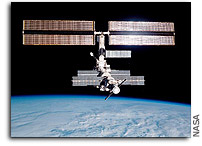NASA Space Station On-Orbit Status 22 August 2004

SpaceRef note: This NASA Headquarters internal status report, as presented here, contains additional, original material produced by SpaceRef.com (copyright © 2004) to enhance access to related status reports and NASA activities.
All ISS systems continue to function nominally, except those noted previously or below. Sunday and regular crew rest day. Ahead: A busy Week 17 for Expedition 9 with lots of excitement (EMU troubleshooting, EVA prep, more 15P transfers, new SSC software loading ops, and Russian ASN Global Nav System testing).
Gennady Padalka conducted the routine inspection of the SM’s environment control & life support system (SOZh), with the weekly data collection of toilet flush counter readings, inspection of the SP urine collection and pretreat assembly, and SVO water supply status counter readings, all for calldown to TsUP/Moscow. Today’s inspection also included the BRPK air/liquid condensate separator system.
Michael Fincke held another private family conference (PFC) via S-band/audio and Ku-band/NetMeeting video.
Padalka again had several optional tasks on his Russian task list today, leading off with the periodic inspection of the BIO-5 Rasteniya-2 (“Plants-2”) experiment which researches growth and development of plants under spaceflight conditions in the Lada-5 greenhouse.
|
Previous Reports ISS On-orbit Status [HQ] |
A second task for the CDR was to continue the “Diatomeya” ocean observations program, for which he used the DSR PD-150P video camera and Nikon F5 digital still camera with 85-mm lens from SM windows #7 and #8 to collect photo and video data on bioproductive regions (algae blooms) that appear in the last ten days of August in the North Atlantic areas. [Today’s “must” targets were the North Atlantic’s subpolar oceanic front and the Gulf Stream area, focusing on oceanic algae blooms and anomalies in the surface “cloud” field.]
Gennady also performed another run of the Russian “Ekon” earth photography program for recording environmental damages, today taking Nikon D1 (800mm lens) pictures of oil spills at the city of Eisk and the city of Novorossiysk, Georgia.
As a long-term recurring item on the Russian task list, the CDR was charged with photographing the PKZ-1V Kromka 1-3 contamination experiment tablet deployed during EVA-10 on handrail 2614 of the DC-1 “Pirs” docking compartment. [The pictures are taken with the Kodak 760 digital still camera (DSC) from the EVA hatch 1 “illyuminator” (window) in the DC-1.]
The Science Officer was thanked for his “Saturday Science” program yesterday, which consisted of a very instructive BSTC (Biotechnology Specimen Temperature Controller) checkout. [“Because of your generous nature in giving your personal time for payloads, we are confident that our hardware is ready to go for the next cellular experiments.”]
In accordance with their daily 2.5-hr. protocol of fisicheskiye uprashneniya (physical exercise), the crew worked out on TVIS treadmill, RED exerciser and VELO cycle with load trainer,
Today’s optional CEO photo targets, in the current LVLH attitude no longer limited by Flight Rule constraints on the use of the Lab nadir/science window, except for the shutter closure and condensation-prevention plan (limited to 90 min. in 24 hours) were Tunis, Tunisia (the crew had a clear nadir view of the Tunis metropolitan port area, but there was a slight chance of dust in the region as well. If present, an image of dust moving through the urban area would be useful for pollution and air quality research), Internal Waves, Bahamas (this overpass should have afforded an opportunity to capture internal waves to the northeast of the Bahamas. The sunglint point was directly below the station), and Lower Amazon River Basin (looking slightly left of track for the estuarine portion of the river basin. Researchers are particularly interested in this region for shoreline and delta sedimentation studies).
CEO images can be viewed at these websites:
See also the website “Space Station Challenge” at:
To view the latest photos taken by the expedition 9 crew visit:
- http://spaceflight.nasa.gov/gallery/images/station/crew-9/ndxpage1.html at NASA’s Human Spaceflight website.
Major upcoming events:
- ISS Reboost-2 — 8/24 (delta-V = 2.2 m/s);
- EVA-11 — 9/3;
- Soyuz 9S launch — 10/9;
- Soyuz 9S dock — 10/11;
- Soyuz 8S undock/land — 10/19;
- Soyuz 9S relocate — 11/18;
- Progress 16P launch — 11/24.
Expedition 9 Flight Crew Plans can be found at http://spaceflight.nasa.gov/station/timelines/
Previous NASA ISS On-orbit Status Reports can be found here. Previous NASA Space Station Status Reports can be found here. Previous NASA Space Shuttle Processing Status Reports can be found here. A collection of all of these reports and other materials relating to Return to Flight for the Space Shuttle fleet can be found here.
|
|
ISS Orbit (as of this morning, 10:59am EDT [= epoch]):
- Mean altitude — 357.8 km
- Apogee height — 363.2 km
- Perigee height — 352.4 km
- Period — 91.7 min.
- Inclination (to Equator) — 51.634 deg
- Eccentricity — 0.0007984
- Solar Beta Angle — -5.6 deg (magnitude decreasing until tomorrow)
- Orbits per 24-hr. day — 15.7
- Mean altitude loss in last 24 hours — 130 m
- Revolutions since FGB/Zarya launch (Nov. ’98) — 32875
ISS Altitude History
Apogee height — Mean Altitude — Perigee height

For more on ISS orbit and worldwide ISS naked-eye visibility dates/times, see http://www.hq.nasa.gov/osf/station/viewing/issvis.html. In addition, information on International Space Station sighting opportunities can be found at http://spaceflight.nasa.gov/realdata/sightings/ on NASA’s Human Spaceflight website. The current location of the International Space Station can be found at http://science.nasa.gov/temp/StationLoc.html at NASA’s Marshall Space Flight Center. Additional satellite tracking resources can be found at http://www.spaceref.com/iss/tracking.html.









